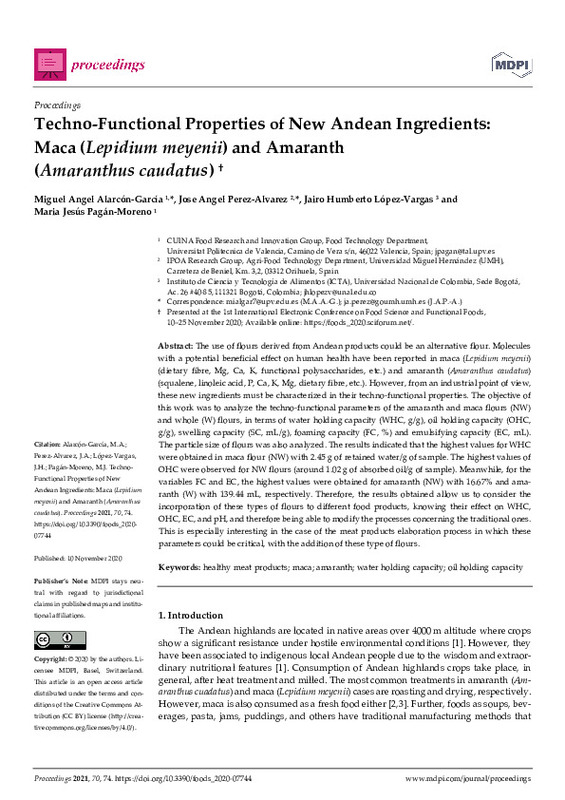JavaScript is disabled for your browser. Some features of this site may not work without it.
Buscar en RiuNet
Listar
Mi cuenta
Estadísticas
Ayuda RiuNet
Admin. UPV
Techno-Functional Properties of New Andean Ingredients: Maca (Lepidium meyenii) and Amaranth (Amaranthus caudatus)
Mostrar el registro sencillo del ítem
Ficheros en el ítem
| dc.contributor.author | Alarcon-Garcia, Miguel Angel
|
es_ES |
| dc.contributor.author | Perez-Alvarez, Jose Angel
|
es_ES |
| dc.contributor.author | López-Vargas, Jairo Humberto
|
es_ES |
| dc.contributor.author | Pagán Moreno, Mª Jesús
|
es_ES |
| dc.date.accessioned | 2022-09-09T18:04:41Z | |
| dc.date.available | 2022-09-09T18:04:41Z | |
| dc.date.issued | 2021 | es_ES |
| dc.identifier.uri | http://hdl.handle.net/10251/185762 | |
| dc.description.abstract | [EN] The use of flours derived from Andean products could be an alternative flour. Molecules with a potential beneficial effect on human health have been reported in maca (Lepidium meyenii) (dietary fibre, Mg, Ca, K, functional polysaccharides, etc.) and amaranth (Amaranthus caudatus) (squalene, linoleic acid, P, Ca, K, Mg, dietary fibre, etc.). However, from an industrial point of view, these new ingredients must be characterized in their techno-functional properties. The objective of this work was to analyze the techno-functional parameters of the amaranth and maca flours (NW) and whole (W) flours, in terms of water holding capacity (WHC, g/g), oil holding capacity (OHC, g/g), swelling capacity (SC, mL/g), foaming capacity (FC, %) and emulsifying capacity (EC, mL). The particle size of flours was also analyzed. The results indicated that the highest values for WHC were obtained in maca flour (NW) with 2.45 g of retained water/g of sample. The highest values of OHC were observed for NW flours (around 1.02 g of absorbed oil/g of sample). Meanwhile, for the variables FC and EC, the highest values were obtained for amaranth (NW) with 16.67% and amaranth (W) with 139.44 mL, respectively. Therefore, the results obtained allow us to consider the incorporation of these types of flours to different food products, knowing their effect on WHC, OHC, EC, and pH, and therefore being able to modify the processes concerning the traditional ones. This is especially interesting in the case of the meat products elaboration process in which these parameters could be critical, with the addition of these type of flours. | es_ES |
| dc.language | Inglés | es_ES |
| dc.publisher | MDPI AG | es_ES |
| dc.relation.ispartof | Proceedings | es_ES |
| dc.rights | Reconocimiento (by) | es_ES |
| dc.subject | Healthy meat products | es_ES |
| dc.subject | Maca | es_ES |
| dc.subject | Amaranth | es_ES |
| dc.subject | Water holding capacity | es_ES |
| dc.subject | Oil holding capacity | es_ES |
| dc.subject.classification | TECNOLOGIA DE ALIMENTOS | es_ES |
| dc.title | Techno-Functional Properties of New Andean Ingredients: Maca (Lepidium meyenii) and Amaranth (Amaranthus caudatus) | es_ES |
| dc.type | Artículo | es_ES |
| dc.identifier.doi | 10.3390/foods_2020-07744 | es_ES |
| dc.rights.accessRights | Abierto | es_ES |
| dc.contributor.affiliation | Universitat Politècnica de València. Departamento de Tecnología de Alimentos - Departament de Tecnologia d'Aliments | es_ES |
| dc.description.bibliographicCitation | Alarcon-Garcia, MA.; Perez-Alvarez, JA.; López-Vargas, JH.; Pagán Moreno, MJ. (2021). Techno-Functional Properties of New Andean Ingredients: Maca (Lepidium meyenii) and Amaranth (Amaranthus caudatus). Proceedings. 70(1):1-7. https://doi.org/10.3390/foods_2020-07744 | es_ES |
| dc.description.accrualMethod | S | es_ES |
| dc.relation.publisherversion | https://doi.org/10.3390/foods_2020-07744 | es_ES |
| dc.description.upvformatpinicio | 1 | es_ES |
| dc.description.upvformatpfin | 7 | es_ES |
| dc.type.version | info:eu-repo/semantics/publishedVersion | es_ES |
| dc.description.volume | 70 | es_ES |
| dc.description.issue | 1 | es_ES |
| dc.identifier.eissn | 2504-3900 | es_ES |
| dc.relation.pasarela | S\439189 | es_ES |








